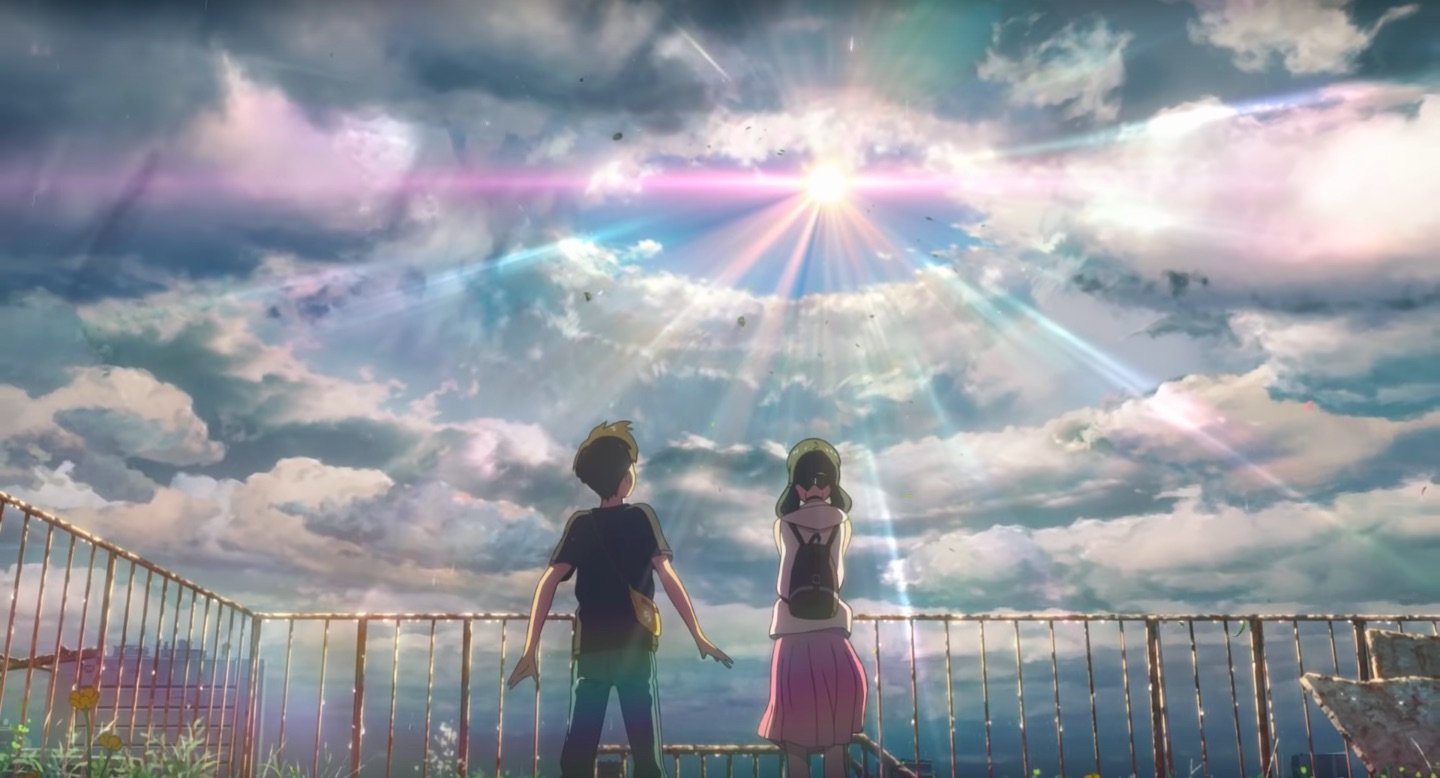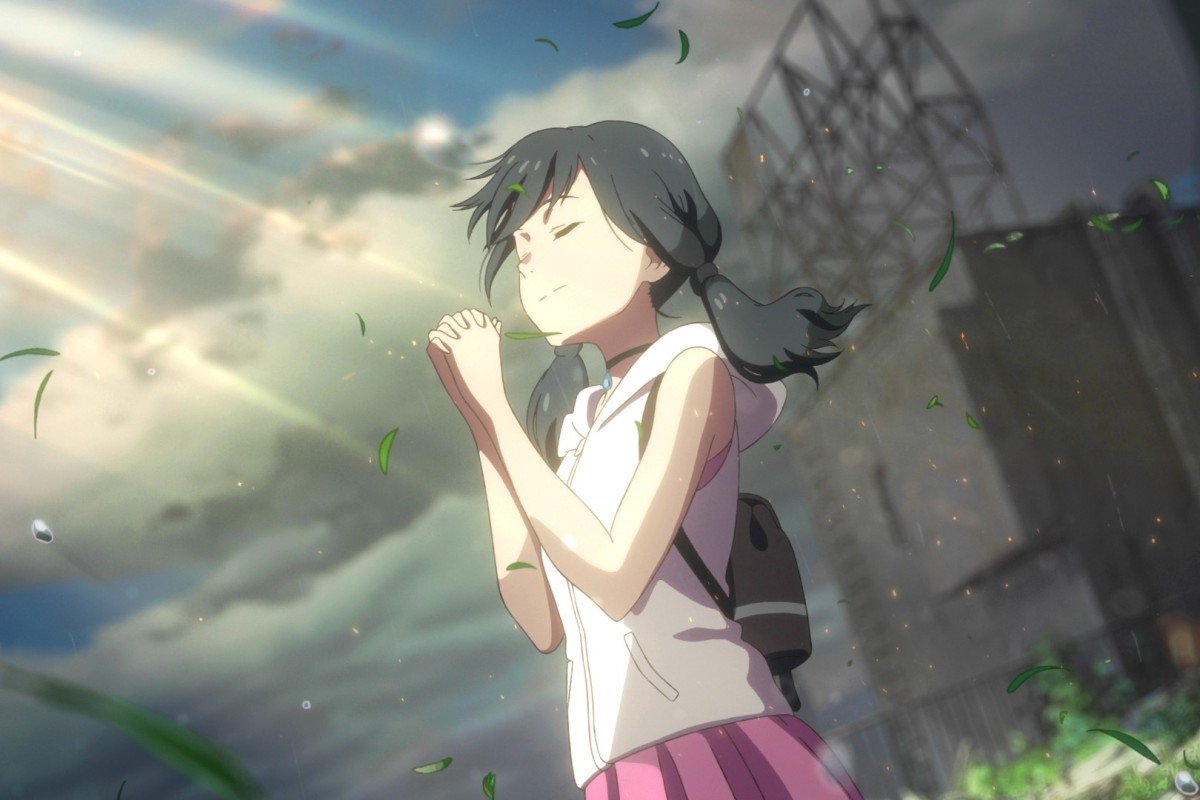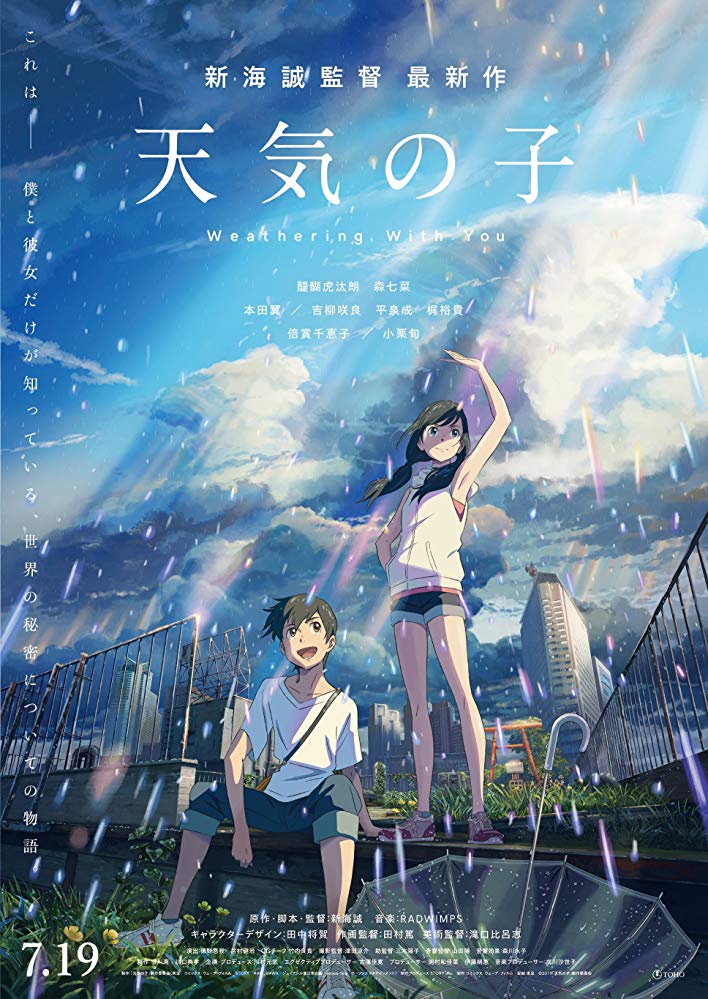by Travis Sanderson
語言:
English
Photo Credit: Weathering with You
TWO BOYS and a girl enter their hotel room. The room is bright and happy, all the more since they spent hours slumped over in the rain, going door to door, rejected by hotel concierge after concierge. They take baths in the massive tub with dreamy underwater light effects. They belt their hearts out to karaoke, standing on the bed covers. What brings the most joy to their faces, however, is the food—a store bin of different flavors of instant ramen, one type after another.
“It’s a feast!” they cry out. They eagerly pass instant ramen cups back and forth, sampling each. “God, if you’re real, please don’t change a single thing,” the older boy, Hodaka prays.
 Film still from Weathering with You. Photo credit: Weathering with You
Film still from Weathering with You. Photo credit: Weathering with You
Deep in the night, when the two boys are asleep, the girl vanishes into thin air. The rain stops, after months of ceaseless pouring, as nature accepts her as its sacrifice.
I am a long-time fan of Makoto Shinkai. I was pleased by his latest installment, Weathering with You, currently in theaters in Taiwan. From impressionist works of raw emotion like 5 Centimeters per Second to films with fleshed out plotlines like Your Name, Shinkai’s creative prowess has expanded with each film produced.
Some critics have argued that the latest installment is a rehashing of Shinkai’s 2016 blockbuster but “lacks the [same] clarity of vision” as Your Name. I thoroughly disagree. Weathering with You does share the same gorgeous animation and feeling as Shinkai’s last movie (in large part, I believe, because of the band Radwimps on the soundtracks of both), but Your Name’s plot was significantly less polished than that of Weathering with You. Shinkai also went one step beyond his previous works. Not only does the movie entertain; it engages the socioeconomic conditions and environmental reality of modern Japan in an original and progressive way.
Two characters, Hodaka and Kei, are reflections of both urban migrants and Japanese economic stagnation. The movie begins with Hodaka arriving in Tokyo after fleeing his family and small-town life. He starts homeless before squatting in a capsule hostel, a popular method to skirt around Tokyo’s astronomical prices. Hodaka scours the internet for jobs in the dark of his pod, eating instant ramen, every night. These dynamics are recognizably Japanese but Hodaka’s economic situation as a school-age boy fleeing his rural home is very similar to other urban migrants in countries like China.
Hodaka personifies a global phenomenon: young, looking for work, and starting new in the big city. Another character, Kei, is a middle-aged man with a very similar biography. He also migrated from rural areas, with little money, to Tokyo. The only real difference between the characters is age. Kei, migrating in the what was probably the 1990s, shares the same life as someone migrating in 2020. The fact that Kei experienced nearly the same life (including falling in love, the subject of the movie’s plot) despite decades of difference illustrates the Japanese economy’s stagnation. The implicit message is that socioeconomic conditions have not considerably changed; rather, the same life of urban poverty has been passed on, generation after generation.
Despite Hodaka’s status as the movie’s protagonist, he is not the most important character in Weathering with You. That honor belongs to Hina Amano, the fifteen-year-old orphan “sunshine girl” with the power to change the weather. Although Hina can be read as a superhuman, with characteristics drawn from traditional and Shinto folklore, she does not come from privilege or high social status. Instead, she works at McDonald’s.
 Film still from Weathering with You. Photo credit: Weathering with You
Film still from Weathering with You. Photo credit: Weathering with You
We first meet Hina as a waitress that takes pity on homeless Hodaka by providing him with his first real meal in weeks, free of charge. Hina’s time flipping burgers is cut short when she is fired and forced to find a different job to take care of herself and her brother. The plot is propelled at every turn by Hina’s need to make money to survive. Hodaka and Hina reunite when he witnesses her with older, shadier men, making an employment deal in what is implied to be sex work. And Hina starts to use her power to change the weather at Hodaka’s prompting when they discover that they can charge for the service of providing the sun, briefly and fleetingly, to customers.
Hina’s character trajectory touches on gender in Japanese socioeconomic conditions. In the first ten years of Japan’s recession, the first Lost Decade, the traditional sarariman life-long career was replaced by one where both men and women worked often worked odd jobs to make ends meet. Hina is no different. She works odd jobs, motivated by the need to make money and nothing else. The “sunshine girl” Hina Amano comes from desperate conditions, recognizable to working-class people in both Japan and worldwide, but finds a way to be happy by using her powers to make others happy, as well. Ironically, that is also why Hina eventually vanishes.
In the scene described at the beginning of this review, the socioeconomic and ecological themes of Weathering with You come to a head. The scene is a Last Supper of sorts. But, true to the socioeconomic background of the characters, what they call a “feast” is no massive banquet. Instead, it is just different flavors of instant ramen. Nonetheless, as in the Last Supper, that night signals the end of the second act of the story. Hina Amano finally becomes the sacrifice that nature requires to balance itself and bring the sun back. It was the best of the times; it was the worst of times.
In the progress of making money as a “sunshine girl,” Hina throws the environment out of balance. The result is parallel in modern environmental reality. Like Hina, the human species has pursued profit at an environmental cost that may lead to a vanishment similar to hers, a fact most recently crystallized in Greta Thunberg’s memorable speech to the United Nations.
But the environmental consciousness of Weathering with You goes beyond modern activism, suggesting that ecological balance is karmic in nature. Hina acquires her powers and shines the sun in one area; the rainwater slams onto Hodaka and Kei’s boat in the Tokyo harbor, dumped from the sky like from a bucket. Hina uses her powers again; the rainwater dumps onto two random schoolboys in an alley, soaking them completely. The rain hits with stronger force in one place proportionate to the sun Hina calls forth somewhere else.
In the final act of the film, Tokyo is flooded. Huge parts of the city are destroyed, underwater, just like scientists predict will occur to most coastal cities around the world as sea levels rise. Yet life goes on.
 Poster for Weathering with You
Poster for Weathering with You
In engaging with a society following what many would describe as a climate apocalypse, Shinkai enters a dialogue with thinkers like Jonathan Franzen, whose recent article in the New Yorker called for us to start contemplating the possibility that we no longer have time to reverse the environmental trajectory of the planet. One character is an environmental refugee, in the last act. But instead of expressing the inevitable suffering of such loss, she observes that “[My old neighborhood] used to be underwater. Humanity changed it slowly. . . I think it’s just gone back to its original self.” She makes a compelling point. Around the world, from Hangzhou to Venice, humans altered the geography to provide for our own settlement. To this character, nature has returned to normal. Such a view is heavily influenced by an environmental worldview wherein humans are a tiny component. The world goes on. Humans adapt. “Don’t sweat it. The world always has been crazy, anyway,” laughs Kei, from his cramped but larger office space.
Ultimately, Weathering with You is a story of working-class teenagers as victims and agents of environmental transformation. It is a beautiful piece of magical realism, where fish swim into the air, suspending reality for moments of humanity. It is also a deeply radical film. The story normalizes and humanizes the socioeconomic reality that many Japanese, and global, youths live day in and day out. Socioeconomic conditions are both pervasive and an afterthought, a fact but not the focus of the film. Rather than be gripped in terror at the climate apocalypse, the movie uses ecology to give us a glimpse of a hopeful future.
The world will likely change due to our poor stewardship. The norm, and perhaps the necessity right now, is to do our best to reverse the tide that our pursuit of money caused. But we can also evolve with the environment. The apocalypse is not the end of the world. The world goes on with or without us and we are just small dots in the rainy sky.

